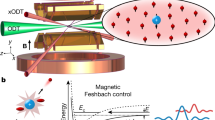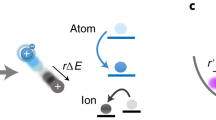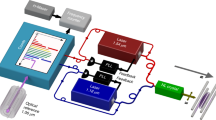Abstract
Precision spectroscopy of atomic systems1 is an invaluable tool for the study of fundamental interactions and symmetries2. Recently, highly charged ions have been proposed to enable sensitive tests of physics beyond the standard model2,3,4,5 and the realization of high-accuracy atomic clocks3,5, owing to their high sensitivity to fundamental physics and insensitivity to external perturbations, which result from the high binding energies of their outer electrons. However, the implementation of these ideas has been hindered by the low spectroscopic accuracies (of the order of parts per million) achieved so far6,7,8. Here we cool trapped, highly charged argon ions to the lowest temperature reported so far, and study them using coherent laser spectroscopy, achieving an increase in precision of eight orders of magnitude. We use quantum logic spectroscopy9,10 to probe the forbidden optical transition in 40Ar13+ at a wavelength of 441 nanometres and measure its excited-state lifetime and g-factor. Our work unlocks the potential of highly charged ions as ubiquitous atomic systems for use in quantum information processing, as frequency standards and in highly sensitive tests of fundamental physics, such as searches for dark-matter candidates11 or violations of fundamental symmetries2.
This is a preview of subscription content, access via your institution
Access options
Access Nature and 54 other Nature Portfolio journals
Get Nature+, our best-value online-access subscription
$29.99 / 30 days
cancel any time
Subscribe to this journal
Receive 51 print issues and online access
$199.00 per year
only $3.90 per issue
Buy this article
- Purchase on Springer Link
- Instant access to full article PDF
Prices may be subject to local taxes which are calculated during checkout





Similar content being viewed by others
Data availability
The datasets generated and analysed during this study are available from the corresponding author upon reasonable request.
References
Ludlow, A. D., Boyd, M. M., Ye, J., Peik, E. & Schmidt, P. O. Optical atomic clocks. Rev. Mod. Phys. 87, 637–701 (2015).
Safronova, M. S. et al. Search for new physics with atoms and molecules. Rev. Mod. Phys. 90, 025008 (2018).
Schiller, S. Hydrogenlike highly charged ions for tests of the time independence of fundamental constants. Phys. Rev. Lett. 98, 180801 (2007).
Berengut, J., Dzuba, V. & Flambaum, V. Enhanced laboratory sensitivity to variation of the fine-structure constant using highly charged ions. Phys. Rev. Lett. 105, 120801 (2010).
Kozlov, M. G., Safronova, M. S., Crespo López-Urrutia, J. R. & Schmidt, P. O. Highly charged ions: optical clocks and applications in fundamental physics. Rev. Mod. Phys. 90, 045005 (2018).
Draganić, I. et al. High precision wavelength measurements of QED-sensitive forbidden transitions in highly charged argon ions. Phys. Rev. Lett. 91, 183001 (2003).
Soria Orts, R. et al. Zeeman splitting and g factor of the 1s 22s 22p 2P3/2 and 2P3/2 levels in Ar13+. Phys. Rev. A 76, 052501 (2007).
Mäckel, V., Klawitter, R., Brenner, G., Crespo López-Urrutia, J. R. & Ullrich, J. Laser spectroscopy on forbidden transitions in trapped highly charged Ar13+ Ions. Phys. Rev. Lett. 107, 143002 (2011).
Schmidt, P. O. et al. Spectroscopy using quantum logic. Science 309, 749–752 (2005).
Wineland, D. J., Bergquist, J. C., Bollinger, J. J., Drullinger, R. E. & Itano, W. M. Quantum computers and atomic clocks. In Proc. 6th Symp. on Frequency Standards and Metrology (ed. Gill, P.) 361–368 (World Scientific, 2002).
Derevianko, A. & Pospelov, M. Hunting for topological dark matter with atomic clocks. Nat. Phys. 10, 933–936 (2014).
Gumberidze, A. et al. Quantum electrodynamics in strong electric fields: the ground-state Lamb shift in hydrogenlike uranium. Phys. Rev. Lett. 94, 223001 (2005).
Beiersdorfer, P., Osterheld, A. L., Scofield, J. H., Crespo López-Urrutia, J. R. & Widmann, K. Measurement of QED and hyperfine splitting in the 2s 1/2–2p 3/2 X-ray transition in Li-like 209Bi80+. Phys. Rev. Lett. 80, 3022–3025 (1998).
Beiersdorfer, P., Chen, H., Thorn, D. B. & Träbert, E. Measurement of the two-loop Lamb shift in lithiumlike U89+. Phys. Rev. Lett. 95, 233003 (2005).
Beiersdorfer, P. et al. Hyperfine splitting of the 2s 1/2 and 2p 1/2 levels in Li- and Be-like ions of \({}_{59}{}^{141}\Pr \). Phys. Rev. Lett. 112, 233003 (2014).
Sturm, S. et al. g factor of hydrogenlike 28Si13+. Phys. Rev. Lett. 107, 023002 (2011).
Arapoglou, I. et al. g-factor of boronlike argon 40Ar13+. Phys. Rev. Lett. 122, 253001 (2019).
Crespo López-Urrutia, J. R., Beiersdorfer, P., Savin, D. W. & Widmann, K. Direct observation of the spontaneous emission of the hyperfine transition F = 4 to F = 3 in ground state hydrogenlike 165Ho66+ in an electron beam ion trap. Phys. Rev. Lett. 77, 826–829 (1996).
Seelig, P. et al. Ground state hyperfine splitting of hydrogenlike 207Pb81+ by laser excitation of a bunched ion beam in the GSI experimental storage ring. Phys. Rev. Lett. 81, 4824–4827 (1998).
Ullmann, J. et al. High precision hyperfine measurements in Bismuth challenge bound-state strong-field QED. Nat. Commun. 8, 15484 (2017).
Gruber, L. et al. Evidence for highly charged ion Coulomb crystallization in multicomponent strongly coupled plasmas. Phys. Rev. Lett. 86, 636–639 (2001).
Schwarz, M. et al. Cryogenic linear Paul trap for cold highly charged ion experiments. Rev. Sci. Instrum. 83, 083115–083115–10 (2012).
Schmöger, L. et al. Coulomb crystallization of highly charged ions. Science 347, 1233–1236 (2015).
Schmöger, L. Kalte hochgeladene Ionen für Frequenzmetrologie. PhD thesis, Univ. of Heidelberg (2017).
Rosenband, T. et al. Frequency ratio of Al+ and Hg+ single-ion optical clocks; metrology at the 17th decimal place. Science 319, 1808–1812 (2008).
Chou, C. W., Hume, D. B., Koelemeij, J. C. J., Wineland, D. J. & Rosenband, T. Frequency comparison of two high-accuracy Al+ optical clocks. Phys. Rev. Lett. 104, 070802 (2010).
Brewer, S. M. et al. 27Al+ quantum-logic clock with a systematic uncertainty below 10−18. Phys. Rev. Lett. 123, 033201 (2019).
Wolf, F. et al. Non-destructive state detection for quantum logic spectroscopy of molecular ions. Nature 530, 457–460 (2016).
Chou, C. et al. Preparation and coherent manipulation of pure quantum states of a single molecular ion. Nature 545, 203–207 (2017).
Hempel, C. et al. Entanglement-enhanced detection of single-photon scattering events. Nat. Photon. 7, 630–633 (2013).
Wan, Y. et al. Precision spectroscopy by photon-recoil signal amplification. Nat. Commun. 5, 3096 (2014).
Micke, P. et al. The Heidelberg compact electron beam ion traps. Rev. Sci. Instrum. 89, 063109 (2018).
Schmöger, L. et al. Deceleration, precooling, and multi-pass stopping of highly charged ions in Be+ Coulomb crystals. Rev. Sci. Instrum. 86, 103111 (2015).
Leopold, T. et al. A cryogenic radio-frequency ion trap for quantum logic spectroscopy of highly charged ions. Rev. Sci. Instrum. 90, 073201 (2019).
Micke, P. et al. Closed-cycle, low-vibration 4 K cryostat for ion traps and other applications. Rev. Sci. Instrum. 90, 065104 (2019).
King, S. A., Leopold, T., Thekkeppatt, P. & Schmidt, P. O. A self-injection locked DBR laser for laser cooling of beryllium ions. Appl. Phys. B 124, 214 (2018).
Matei, D. G. et al. 1.5 μ m lasers with sub-10 mHz linewidth. Phys. Rev. Lett. 118, 263202 (2017).
Stenger, J., Schnatz, H., Tamm, C. & Telle, H. Ultraprecise measurement of optical frequency ratios. Phys. Rev. Lett. 88, 073601 (2002).
Lapierre, A. et al. Lifetime measurement of the Ar XIV \(1{s}^{2}2{s}^{2}2{p}^{2}{P}_{3/2}^{{\rm{o}}}\) metastable level at the Heidelberg electron-beam ion trap. Phys. Rev. A 73, 052507 (2006).
Tupitsyn, I. I. et al. Magnetic-dipole transition probabilities in B-like and Be-like ions. Phys. Rev. A 72, 062503 (2005).
Bilal, M., Volotka, A. V., Beerwerth, R. & Fritzsche, S. Line strengths of QED-sensitive forbidden transitions in B-, Al-, F- and Cl-like ions. Phys. Rev. A 97, 052506 (2018).
Glazov, D. A. et al. g factor of boron-like ions: ground and excited states. Phys. Scr. T156, 014014 (2013).
Verdebout, S. et al. Hyperfine structures and Landé g J-factors for n = 2 states in beryllium-, boron-, carbon-, and nitrogen-like ions from relativistic configuration interaction calculations. At. Data Nucl. Data Tables 100, 1111–1155 (2014).
Marques, J. P., Indelicato, P., Parente, F., Sampaio, J. M. & Santos, J. P. Ground-state Landé g factors for selected ions along the boron isoelectronic sequence. Phys. Rev. A 94, 042504 (2016).
Agababaev, V. A. et al. g factor of the [(1s)2(2s)22p]2P 3/2 state of middle-Z boronlike ions. X-ray Spectrom. 49, 143–148 (2019).
Shchepetnov, A. A. et al. Nuclear recoil correction to the g factor of boron-like argon. J. Phys. Conf. Ser. 583, 012001 (2015).
Maison, D. E., Skripnikov, L. V. & Glazov, D. A. Many-body study of the g factor in boronlike argon. Phys. Rev. A 99, 042506 (2019).
Berkeland, D. J., Miller, J. D., Bergquist, J. C., Itano, W. M. & Wineland, D. J. Minimization of ion micromotion in a Paul trap. J. Appl. Phys. 83, 5025–5033 (1998).
Itano, W. M. External-field shifts of the 199Hg+ optical frequency standard. J. Res. Natl Inst. Stand. Technol. 105, 829–837 (2000).
Madej, A. A., Dubé, P., Zhou, Z., Bernard, J. E. & Gertsvolf, M. 88Sr+ 445-THz single-ion reference at the 10−17 level via control and cancellation of systematic uncertainties and its measurement against the SI second. Phys. Rev. Lett. 109, 203002 (2012).
Barwood, G. P., Huang, G., King, S. A., Klein, H. A. & Gill, P. Frequency noise processes in a strontium ion optical clock. J. Phys. At. Mol. Opt. Phys. 48, 035401 (2015).
Egl, A. et al. Application of the continuous Stern–Gerlach effect for laser spectroscopy of the 40Ar13+ fine structure in a Penning trap. Phys. Rev. Lett. 123, 123001 (2019).
Mandal, P., Sikler, G. & Mukherjee, M. Simulation study and analysis of a compact einzel lens-deflector for low energy ion beam. J. Instrum. 6, P02004 (2011).
Kreckel, H. et al. A simple double-focusing electrostatic ion beam deflector. Rev. Sci. Instrum. 81, 063304 (2010).
Barton, P. A. et al. Measurement of the lifetime of the 3d 2D 5/2 state in 40Ca+. Phys. Rev. A 62, 032503 (2000).
Letchumanan, V., Wilson, M., Gill, P. & Sinclair, A. Lifetime measurement of the metastable 4d 2D 5/2 state in 88Sr+ using a single trapped ion. Phys. Rev. A 72, 012509 (2005).
Acknowledgements
We acknowledge I. Arapoglou, H. Bekker, S. Bernitt, K. Blaum, A. Egl, S. Hannig, S. Kühn, T. Legero, R. Müller, J. Nauta, J. Stark, U. Sterr, S. Sturm and A. Surzhykov for support and discussions. We also thank the MPIK engineering design office, the electronics workshops of QUEST and MPIK, IMPT Hannover, and PTB division 4 for support and technical help. In particular, we thank the mechanical workshop of MPIK and the scientific instrumentation department (5.5) of PTB for their skilful and timely manufacturing of our devices. The project was supported by the Physikalisch-Technische Bundesanstalt, the Max-Planck Society, the Max-Planck–Riken–PTB–Center for Time, Constants and Fundamental Symmetries, and the Deutsche Forschungsgemeinschaft (DFG, German Research Foundation) through SCHM2678/5-1, the collaborative research centres SFB 1225 ISOQUANT and SFB 1227 DQ-mat, and Germany’s Excellence Strategy – EXC-2123/1 QuantumFrontiers. This project also received funding from the European Metrology Programme for Innovation and Research (EMPIR), which is co-financed by the Participating States, and from the European Union’s Horizon 2020 research and innovation programme (project number 17FUN07 CC4C). S.A.K. acknowledges financial support from the Alexander von Humboldt Foundation.
Author information
Authors and Affiliations
Contributions
P.M., T.L., S.A.K., E.B., L.S., M.S., J.R.C.L.-U. and P.O.S. developed the experimental setup. P.M., T.L., S.A.K. and L.J.S. carried out the experiments. P.M. and T.L. analysed the data. J.R.C.L.-U. and P.O.S. conceived and supervised the study. P.M. and P.O.S. wrote the initial manuscript with contributions from T.L., S.A.K. and J.R.C.L.-U. All authors discussed the results and reviewed the manuscript.
Corresponding authors
Ethics declarations
Competing interests
The authors declare no competing interests.
Additional information
Peer review information Nature thanks Andrei Derevianko and the other, anonymous, reviewer(s) for their contribution to the peer review of this work.
Publisher’s note Springer Nature remains neutral with regard to jurisdictional claims in published maps and institutional affiliations.
Extended data figures and tables
Extended Data Fig. 1 Experimental setup.
a, Top view of the setup. The apparatus extends over two rooms separated by an acoustically insulating wall. Inside the ‘machine room’ on the right-hand side, HCIs are produced in an EBIT32 and extracted as ion bunches along the ion beam trajectory (blue line) through a deceleration beamline. At the laser laboratory (left side), they are axially injected into a cryogenic linear Paul trap34, which is mounted on a pneumatically floating optical table (grey-shaded). The Paul trap is refrigerated by a vibrationally decoupled pulse tube cryocooler35 located in the machine room. The beamline is composed of several ion optical elements: five segmented einzel lenses and an electrostatic 90° deflector for guiding and focusing the ions, a pair of pulsed drift tubes for deceleration, and six cylindrical electrodes arranged in line in front of and behind the Paul trap. Charge-state separation is accomplished by the different times of flight through the beamline. One electrode of the third segmented einzel lens is used as a gate to select the desired charge state. An MCP detector in front of the Paul trap includes two fine stainless-steel meshes that apply a well defined retarding field, and allows the measurement of the kinetic-energy distribution of the ion bunches (see also Extended Data Fig. 2e, f). A second MCP detector behind the Paul trap is used to optimize the ion beam transmission through the Paul trap. b, Magnified side view of the cryogenic Paul trap region. The trap (photograph) is shown with the two adjacent electrostatic tubes. The left one (mirror tube) at the entrance of the Paul trap is used to capture the HCIs by rapidly switching to a confining potential once the HCIs have passed it. Photograph: Physikalisch-Technische Bundesanstalt.
Extended Data Fig. 2 HCI extraction and transfer.
a, Simplified illustration of the electrostatic potential used for the 40Ar13+ transfer from the EBIT to the Paul trap. The entire ion inventory stored in the EBIT, with its charge-state distribution displayed as grey-shaded, is ejected by switching the axial trap to a repulsive potential. The charge states separate owing to their distinct initial kinetic energies. 40Ar13+ ions (red) are selected by an electrode used as a gate (not shown). The fast 40Ar13+ bunch is then slowed down upon entering the pulsed drift tubes. Having arrived there at the centre of a linear potential gradient, the electrode potentials are rapidly switched to ground, and a slower 40Ar13+ bunch leaves the pulsed drift tubes. At the Paul trap, the ions are further decelerated by an electrostatic potential and enter the trapping region with a reduced residual kinetic energy of 5q V to 10q V. They then pass a Coulomb crystal of 9Be+ ions and are reflected by an electrostatic endcap electrode biased to a potential of about 12 V above the biased common ground. Meanwhile, an electrostatic mirror tube in front of the Paul trap has been switched up to a confining potential at which 40Ar13+ is unable to escape the Paul trap. This causes an oscillatory motion along the trap axis. Through repeated interactions with the laser-cooled 9Be+ ions, 40Ar13+ dissipates its residual kinetic energy and joins the Coulomb crystal. b, Normalized ion yield as a function of the time of flight after ion ejection from the EBIT, measured by the first MCP detector in front of the Paul trap. The black curve shows the entire charge-state distribution, with Ar charge states from +7 through +15. Using the gate electrode, 40Ar13+ is chosen for passage, as shown by the red curve. a.u., arbitrary units. c, d, Normalized 40Ar13+ bunches as a function of time and position along the beamline axis (averaged over 16 shots). The FWHM of the fast bunch is about 250 ns (c) and that of the slow bunch is about 185 ns (d). e, f, Normalized kinetic-energy distributions of the 40Ar13+ bunches along the beamline axis: fast bunch (e) and slow bunch after deceleration and phase-space cooling using the pulsed drift tubes (f). The red circles show the integrated ion yield of an averaged 40Ar13+ bunch (16 shots) for a given retardation potential, measured by the retarding-field analyser. A Gaussian error function (red line) was fitted to the data and differentiated to obtain the Gaussian energy distribution (blue line) to show the mean kinetic energy and longitudinal energy spread.
Extended Data Fig. 3 Quantum logic-assisted internal state preparation of Ar13+.
The m1/2 = −1/2 state of the 2P1/2 level is deterministically populated by a series of five clock laser sideband π-pulses (1–5), which excite the two-ion crystal from the motional ground state \({|0\rangle }_{m}\) (solid lines) into the excited state \({|1\rangle }_{m}\) (dashed lines). By means of Raman sideband cooling pulses acting on the 9Be+ ion, the crystal is returned to the motional ground state after each transfer pulse. This ensures unidirectional optical pumping9. To increase the state-preparation efficiency, this sequence is repeated four times. The other Zeeman ground state (2P1/2, m1/2 = +1/2) is prepared in an analogous manner.
Rights and permissions
About this article
Cite this article
Micke, P., Leopold, T., King, S.A. et al. Coherent laser spectroscopy of highly charged ions using quantum logic. Nature 578, 60–65 (2020). https://doi.org/10.1038/s41586-020-1959-8
Received:
Accepted:
Published:
Issue Date:
DOI: https://doi.org/10.1038/s41586-020-1959-8
This article is cited by
-
Hyperfine-structure-resolved laser spectroscopy of many-electron highly charged ions
Communications Physics (2023)
-
An optical atomic clock based on a highly charged ion
Nature (2022)
-
Quantum logic detection of collisions between single atom–ion pairs
Nature Physics (2022)
-
Highly charged ion used in a new class of optical clock
Nature (2022)
-
Sympathetic cooling of a trapped proton mediated by an LC circuit
Nature (2021)
Comments
By submitting a comment you agree to abide by our Terms and Community Guidelines. If you find something abusive or that does not comply with our terms or guidelines please flag it as inappropriate.



